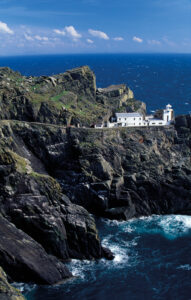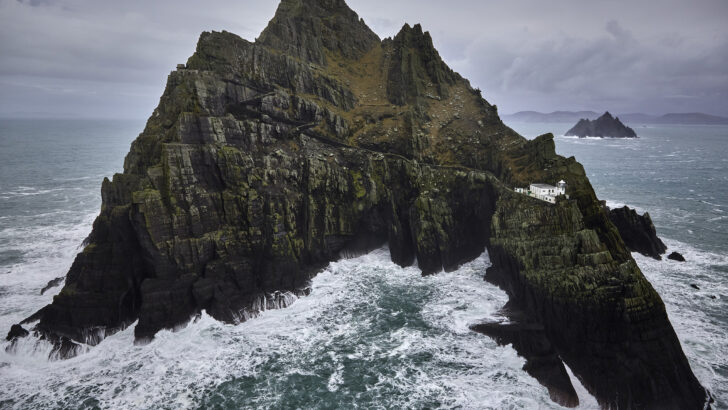The Book of the Skelligs, edited by John Crowley and John Sheehan, photography by Valerie O’Sullivan (Cork University Press, €49/£43.90)
The Great Lighthouses of Ireland, by David Hare (Gill Books, €27.99/£24.99)
The filming in the recent past of two episodes of the continuing Star Wars franchise has transformed the world-wide perception of the Skellig islands with their 1,400-year history as a renowned site of Early Christian Ireland.
It even led to a “family friendly, fun filled weekend festival”, which had only to do with modern fantasy culture. But many associated with the Office of Public Works were very concerned about what was coming to pass and rightly so. We have to face the fact that all tourism promotion ventures are not equal, and some do more harm than good in boosting the local economies, damage that can eventually destroy what so many people came to see.
But here is a book which more than compensates for all that. It is a simply stunning compendium on all aspects of the islands, a sort of holistic integrated treatment of the archipelago that is endlessly fascinating in itself.
It has been put together by John Crowley and John Sheehan, and largely photographed by a single photographer Valerie O’Sullivan, which gives the book a wonderful integrated single vision of the place.
The editors, both of whom are attached to Cork University College, assembled a group of 26 contributors who have provided some 50 articles of a very varied kind, some scientific, some historical, others purely meditative and literary.
Geology
It starts very properly with the geology of the islands, with the very bedrock that gives the Skellig skyline that extraordinary shark’s tooth appearance that so appealed to the American film producers. They responded to the sensational appearance, but the writers here are creating a fact-based treatment. The first four sections deal in fact with flowers and animal life, the birds notably the puffins and gannets, whose cries and squawks in the breeding season are an essential part of the atmosphere.
I was struck especially by Vincent Hyland’s essay, entitled “The Galapagos of Europe”. Well, I thought at first, where are the finches, lizards and tortoises that were so important to Darwin in the Pacific. But once he gets under the surface of the sea, down into the depths, he reveals an extraordinary world teeming with life and colour.
Having created this solid ground in the natural environment, the book then turns to various aspects of the Skelligs in Irish monasticism and history, standing as it did then at the edge of the “known world”. There follow pieces that deal with medieval architecture of the island, which is indeed incredible given the difficulty of working on such a location.

The monks are long gone. But in modern times the islands have not been quite devoid of a population: there have been the operators of the light house since 1826, and a profile by one of the editors deals with Grellan D. Rourke, who passed some 40 years on the island. This is a remarkable document. The modern residents are only too well aware of the dangers, for one of them once fell to his death trying to harvest fodder for the cow that provided the fresh milk supply to the lighthouse keepers.
I have often wondered in the past whether the anchorites spent the whole year on the island, or only (as seemed more probably to me) only the summer months; but it seems they did, in their devotion to God and solitude. The seas along our west coast are at their most outrageous in the months of February and March. Though recent archaeological work has investigated many aspects of monastic life, it has not yet answered all the queries that may arise.
On a wider point Damien Bracken provides an essay on the Archangel Michael in medieval Ireland. But on this point it is a pity that an essay was not commissioned on the interrelation of Skellig Michael with Mont Saint-Michel in Normandy and, across La Manche, St Michael’s Mount in Cornwall. These places are surrounded by masses of mythical and legendary lore, far beyond anything that is known about Skellig Michael, lore in which St Michael appears as a protector of the Faithful in danger along these approach seas to the ports of Cork, Southampton, Le Havre and London.
Dangerous
We often forget just how dangerous a place the Celtic Sea and the Channel have been since prehistory to ships and boats. In a presentation of the Hopkins Summer School I spoke some time ago about the extraordinary numbers of lives lost at sea along the course of the Channel in the same year as the Deutschland. Could one of the tasks of the monks of Skellig would have been to pray for those in danger at sea?
A desert to the monks, to sailors it was often an overcrowded waterway. These three dedications suggest a connected idea, but one which means moving outside Ireland to discuss, not always something Irish local scholars like doing.
The book closes out with a selection of essays on various aspects of the islands in the present day, many of great interest. The most interesting of these (to me at least) are three pieces on Skellig and the sky at night; fascinating stuff. The book actually concludes with a photographic evocation by artist and filmmaker Clare Langan, in which she calls them “the floating world”, which seems very apt indeed.
A densely detailed book which is a pleasure to read, and which provides page upon page of information and data, all expressed with a loving care for a single place. But the more that is known, the more we realise how little we actually know; there is always more to learn. Skellig Michael is one of those places that will go on prompting questions in the minds of the curious and meditative.
For many lovers of Kerry The Book of the Skelligs will go on their shelves beside Tom Barrington’s great labour of love.
***
Producer David Hare’s book about the lighthouses of Ireland is also beautifully illustrated (much of the material deriving from his television documentary series), and has pages on the light house on Skellig Michael. One image shows a helicopter taking off above the island, a reminder that modern technology reaches everywhere today, into even into the remotest crannies of our culture. But it is a remarkable record of human achievement, technology and enterprise, and in the lives and activities of the light house men and their families, lives often of sheer courage.
If the photographs are very fine, some of the paintings from the past are extraordinary. The Irish Lights Service is something we all take far too casually. When the lighthouses failed in the past, tragedy too often followed. This is a well justified tribute to a great corps of people.


 Peter Costello
Peter Costello Skellig Michael, looking from the west towards Seal Cove. Photo: Peter Cox.
Skellig Michael, looking from the west towards Seal Cove. Photo: Peter Cox. 